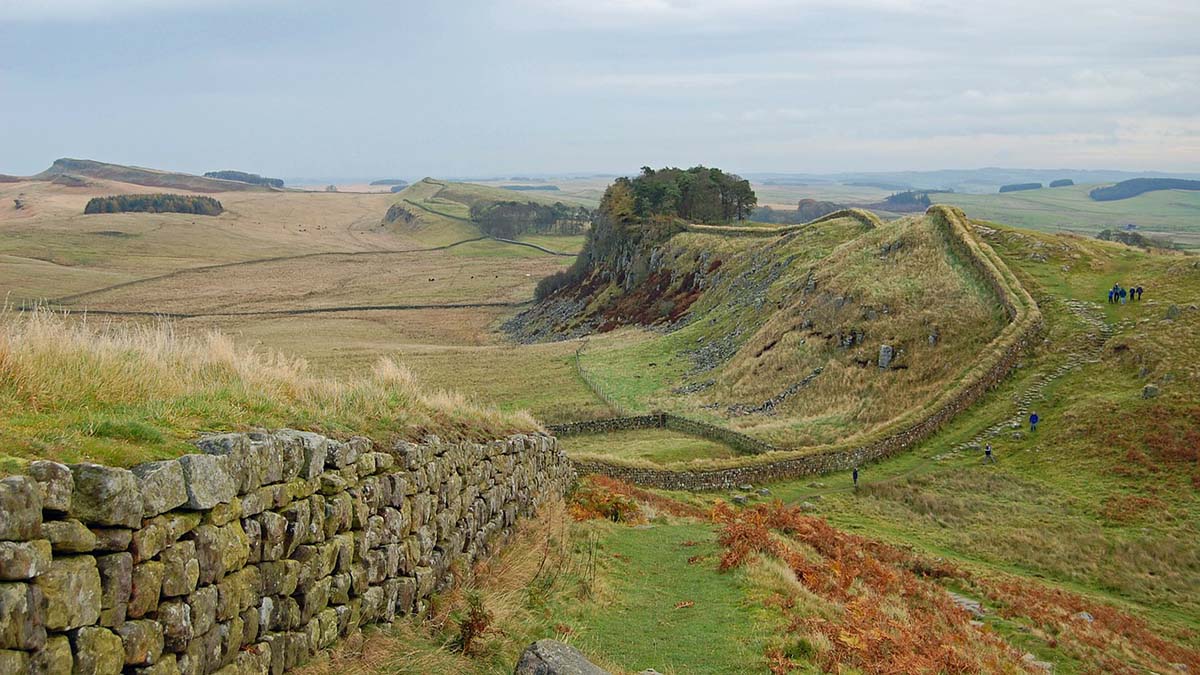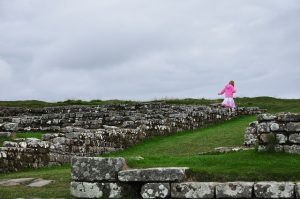
by Melissa Gardiner
It was a bright spring morning as my walking partner and I took our first footsteps along the path of Hadrian’s Wall. It’s an 84-mile trail across the north of England from Wallsend near Newcastle on the east coast to Bowness-on-Solway on the west coast. Or that’s the most popular route, we were travelling west to east as it fitted in better with our travel plans. The Hadrian’s Wall Path is a World Heritage site, passing through historic towns and villages, and sticking very closely to the path of the Roman wall built in AD 142, primarily to protect Roman England from troublesome Scots north of the border. It also passes through some of England’s most notable archaeological sites, dotted across rolling hills and at times, wild, rugged countryside.
Carlisle
 We managed to complete the trail in seven days, walking between 12-15 miles each day and stopping in decent bed and breakfast accommodations or cozy country pubs along the way. There were a number of historical highlights, with the Roman city of Carlisle first along the way. Carlisle is a bustling border town on the banks of the River Eden. Its impressive medieval castle sits high on a hill overlooking the city and is open for tours and visits to its dungeons. We arrived in Carlisle late in the afternoon and after a shower and a bite to eat, enjoyed a few drinks in some of the historic pubs dotted around the center. The King’s Head was the pick of the bunch.
We managed to complete the trail in seven days, walking between 12-15 miles each day and stopping in decent bed and breakfast accommodations or cozy country pubs along the way. There were a number of historical highlights, with the Roman city of Carlisle first along the way. Carlisle is a bustling border town on the banks of the River Eden. Its impressive medieval castle sits high on a hill overlooking the city and is open for tours and visits to its dungeons. We arrived in Carlisle late in the afternoon and after a shower and a bite to eat, enjoyed a few drinks in some of the historic pubs dotted around the center. The King’s Head was the pick of the bunch.
After Carlisle, it was a few days hard walking and taking in the sights of the countryside that runs between the border city in the west and the vibrant city of Newcastle in the east. We spent a night in the quaint market town of Brampton and then headed towards the Housestead Crags, some of the toughest walking on the trail. The trail is well sign-posted for walkers even in the remote areas and we regularly saw plaques marking points where the original wall stood. There are still a few small stretches of the original wall that can be seen, as well as mounds and trenches which now evidence where the wall once ran.
Newcastle
The second half of the trip saw us heading down from the hills towards the north-east coast. Our final day walking took us from the quiet village of Wylam along the banks of the Tyne, right into the heart of Newcastle. It’s an impressive city as you walk along the Quayside area and underneath the magnificent Tyne Bridge. Newcastle has been a major port for centuries and whilst the docks are no longer as busy as in the past, the city has partly re-invented itself as a tourist destination and a starting point for cruises to Northern Europe and the Arctic. Passenger ferries to Holland and Belgium also run out of Newcastle as well. The Hadrian’s Wall trail ends a couple of miles past the city center at Segedunum Roman Fort in the suburb of Wallsend. This has an impressive visitor center with a viewing tower looking over the wide area of excavated fort on show. We saw barracks blocks, command posts and an 80 metre stretch of the original wall as we wandered around the site, tired but delighted that we had completed the trail.
Roman Forts
The historical highlights of the trip however were the old Roman forts that we came across along the way. Hadrian’s Wall is a route for lovers of history and architecture and the forts and the visitor centers that accompany them will not disappoint enthusiasts. Housesteads Roman Fort is found on an escarpment above the trail route. There are substantial remains of the 2000-year old fort and the views out over the rugged crags were spectacular on the clear day that we visited. The site has a museum and exhibition and we wandered through the remains of barracks that once housed over 800 soldiers. In Cumbria we passed Lancercost Priory, an Augustinian Priory which dates back to 1169 and still functions as an Anglican church, as well as paying a brief visit to the remains of Birdoswald Roman Fort – not as impressive as Housesteads but with impressive interactive displays and a full height model of the wall it’s worth the detour from the trail route.
We also stopped for a night in Chollerford, a picturesque Northumberland village and visited the nearby Chesters Roman Fort on the banks of the River Tyne. This was a cavalry fort and there are also remains of Roman baths and steam rooms nearby. As with the other forts along the route, there was an informative visitor center with knowledgeable staff to chat to.
We ended our walk with a look around Segedunum, weary but delighted to have finished the trail. We’d seen history and magnificent rural scenery along the way, but on the final leg of the trip it was time for a metro back into Newcastle city center and an evening enjoying its famous nightlife.

One For the Road – Newcastle Pub Walk
If You Go:
Along with the other places in this article, you may also want to visit:
♦ Durham Cathedral, known for being one of the finest and best examples of Norman architecture in the world
♦ Lindsifarne, home of the monastery of St Cuthbert. Visiting this small, tidal island off the North East coast is a rare and sacred pleasure and will need careful planning, but will be worth every moment.
♦ Monkwearmouth-Jarrow – Visit the remains of the Monastic dwelling of the Venerable Bede, responsible for the creation of the epic tome “Ecclesiastical History of the English People”
♦ Lanercost Priory
♦ Housesteads Roman fort
♦ www.nationaltrail.co.uk/hadrians-wall-path
♦ www.english-heritage.org.uk
♦ Art Cruises: www.iglucruise.com/art-cruises
Photo credits:
Hadrian’s Wall Image by David Mark from Pixabay
Housesteads Roman Fort by Eleonora Pavlovska from Pixabay
About the author:
Melissa Gardiner is now a freelance writer, but prior to this she worked within the travel industry as a tour guide, specializing in sites of historical interest throughout the UK. She has a keen interest in ancient history and loves seeking out places of interest to write about that she feels will interest others as much as herself.



Leave a Reply
You must be logged in to post a comment.